資源
極端高溫天氣
On this page
- 極端酷熱天氣海報
- 高風險人士
- 酷熱天氣對健康的影響
- 在酷熱天氣下保護自己和他人
- 經常查看您的鄰居、朋友和家人,確保他們能夠保持涼爽,並制定應急計劃。這樣可以挽救生命。
- 溫哥華沿岸衛生局 (VCH) 為非政府組織提供的高溫天氣查看現況的支援框架
- 高溫天氣查看現況培訓影片
- 國家環境衛生合作中心 (NCCEH) 極端酷熱天氣健康檢查指南
- 避暑中心和潔淨空氣場所
- 炎熱天氣時建立避暑空間
- 高溫警告和極端高溫緊急情況
- 溫哥華室內溫度調查
- 2021 BC Heat Dome and VCH ER Visits
- 2021 BC Heat Dome and VCH ER Visits
- 為建立和支持更涼快、更安全的室內居住空間的政策工具
- 極端高溫天氣資源
- Resources for health professionals

極端高溫天氣可以非常危險。了解中暑、熱衰竭的症狀,以及如何為酷熱的季節做好準備,以保護您自己以及您的鄰居、朋友和家人的健康。
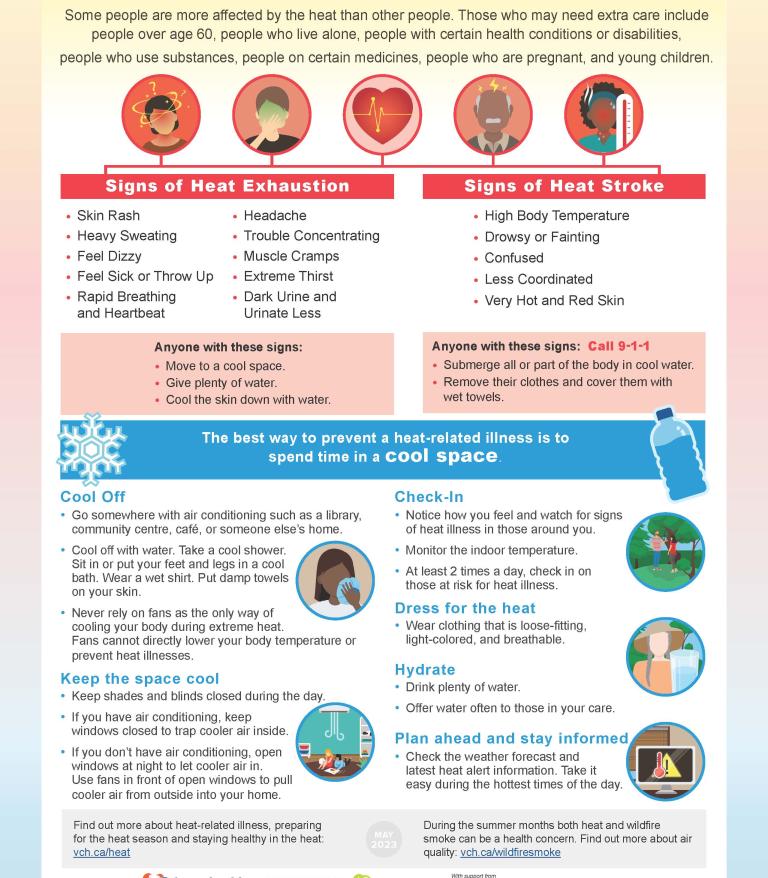
高風險人士
高溫對每個人的影響不盡相同,但有些人的健康可能更容易受到影響。以下人士特別需要注意保持涼爽:
- 60 歲或以上的年長者
- 獨居者
- 已患有例如糖尿病、心臟疾病或呼吸系統疾病等健康問題的人士
- 患有思覺失調症、抑鬱症或焦慮症等精神疾病人士
- 患有物質使用疾患的人士,包括酗酒
- 行動不便人士
- 邊緣無定居所者
- 在酷熱環境中工作的人士
- 孕婦
- 嬰兒和幼兒
其他人士也會受到酷熱天氣的影響。每個人的反應都不同,所以要多留意自己的身體狀況。
酷熱天氣對健康的影響
極端高溫事件,也稱為「熱浪」,可能導致多種高溫相關的疾病,並增加死亡率。高溫相關的疾病是指因酷熱天氣引起的不適,例如熱疹、曬傷、熱痙攣、熱衰竭,以及最嚴重的中暑。
熱衰竭的症狀包括:
- 大量出汗
- 頭暈
- 噁心或嘔吐
- 呼吸急促和心跳加速
- 頭痛
- 注意力難以集中
- 肌肉痙攣
- 極度口渴
- 新出現的皮疹
- 尿液深色和排尿量減少
任何有熱衰竭症狀人士都應該轉移到涼爽的地方、喝水,並在大面積皮膚上敷冷水(涼水浴、淋浴或弄濕衣服)。應立即採取這些步驟,因為熱衰竭可以很快進展成中暑,到時就是醫療緊急情況。
中暑的症狀包括:
- 體溫高( > 攝氏 38 度/華氏 100 度)
- 昏厥或嗜睡
- 意識錯亂
- 缺乏協調能力
- 非常熱和紅的皮膚
中暑是緊急醫療情況。需立即前往急診室或緊急護理中心求醫。如有必要,請致電 911。在等待幫助期間,可以的話,立即將患者移至涼爽的地方降溫,並在大面積皮膚上敷冷水(冷水浴、淋浴或弄濕他們的衣物)。
在酷熱天氣下保護自己和他人
待在涼爽的地方,並多喝水是預防與高溫相關疾病的最佳方法。
- 尋找涼爽的室內和室外空間(例如當地社區中心、圖書館或購物中心。)
- 即使您並不口渴,也請多喝水和其他飲料以保持身體裡的水分。
- 用水降溫,如沖冷水澡或將身體的一部分浸入冷水浴中。
- 穿上濕衣服或用濕毛巾敷在皮膚上降溫。
- 穿上寬鬆、淺色且透氣的衣服。
- 限制活動,尤其是在一天中最炎熱的時段(在卑詩省通常是下午 2 時到 4 時。)
- 上午 10 時左右關閉窗戶,並拉下室內/室外遮陽簾/百葉簾,將涼爽的空氣保留在室內和阻擋陽光。
- 晚上 9-10 時左右打開門窗,讓涼爽的夜間空氣進入(確定室外溫度比室內低。)
- 策略性地使用一台或多台風扇,以幫助將較涼爽的空氣在晚間過夜時抽入家中。
- 使用通常位於廚房和浴室的排風扇,將室內的熱氣排到室外,並在晚間過夜時打開窗戶抽入較涼爽的室外空氣。
- 考慮於家中安裝空調;如有空調,請確保開啟。
- 監測自己和被照護者人士的室內溫度。
- 留意熱衰竭和中暑的症狀。對於易因高溫而引起不適的人士而言,室內溫度超過攝氏 26 度(華氏 78 度)的情況下,患上高溫相關疾病的風險可能會增加,而在室內溫度超過攝氏 31 度(華氏 88 度)時,風險甚至會大幅度增加。
山火的煙霧也會對健康構成影響。如山火煙霧和酷熱天氣同時出現時,請考慮使用備有高效濾網 (high-efficiency particulate air, HEPA) 的空氣淨化器來過濾空氣。了解更多關於山火煙霧的資訊。
經常查看您的鄰居、朋友和家人,確保他們能夠保持涼爽,並制定應急計劃。這樣可以挽救生命。
在以往的酷熱天氣出現時,大部分死者都在家中並是社交孤立的人士。
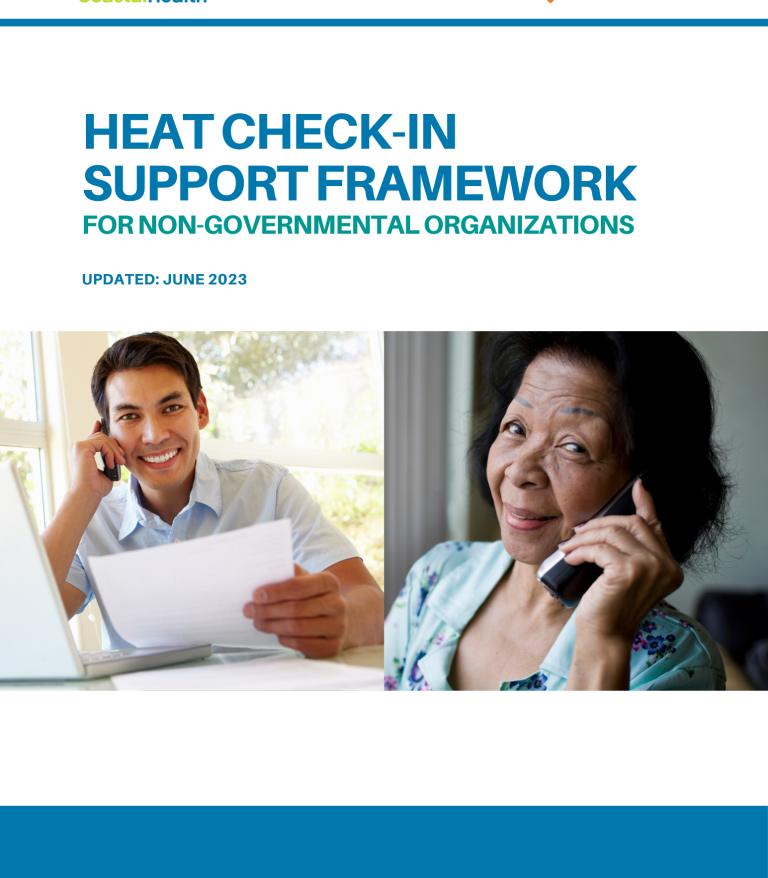
溫哥華沿岸衛生局 (VCH) 為非政府組織提供的高溫天氣查看現況的支援框架
在 2022 年春季,溫哥華沿岸衛生局 (VCH) 健康環境團隊與當地政府和社區組織合作,了解他們需要什麼,來幫助他們進行酷熱天氣查看現況以支援社區成員。合作夥伴指出關於他們如何進行檢查的資料需求,以及解答工作人員和檢查對象預期的常見問題。酷熱天氣查看現況檢查由各種訓練有素的工作人員或志願者,在不同的環境下進行。鑑於廣泛的背景,創建這個框架以便各組織可以選擇與其環境最相關的資訊,來制定各組織自己的查看現況計劃。
下載高溫天氣查看現況的支援框架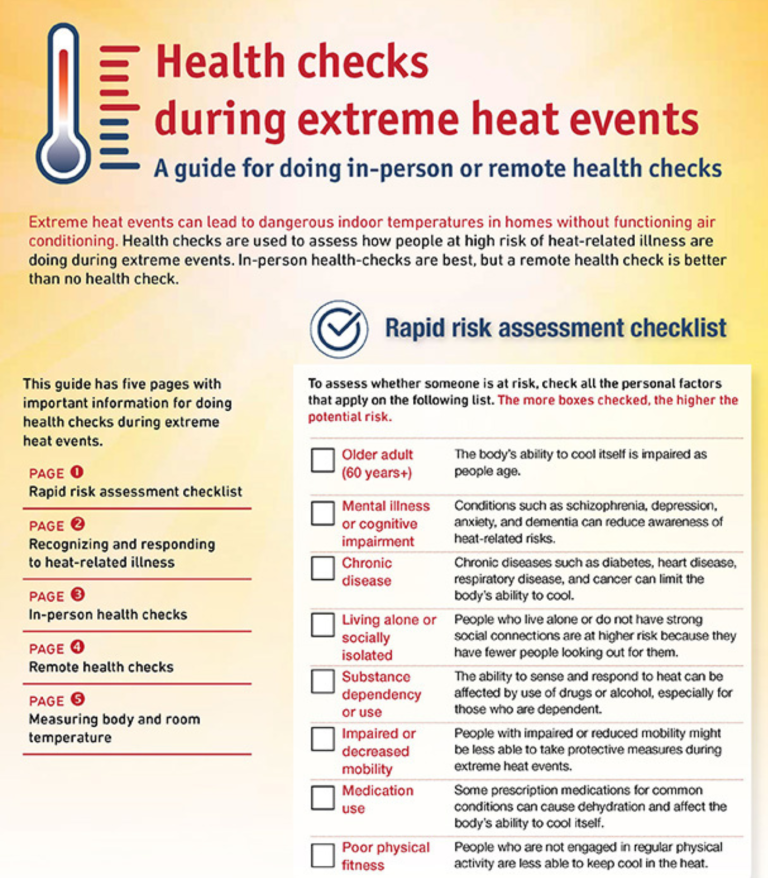
國家環境衛生合作中心 (NCCEH) 極端酷熱天氣健康檢查指南
國家環境衛生合作中心 (National Collaborating Centre for Environmental Health, NCCEH) 制定了一份 5 頁的指南,旨在提供所有關鍵資訊和指引來幫助支援大眾在酷熱天氣期間進行健康檢查。這份工具是由 Glen Kenny 博士和他在渥太華大學 (University of Ottawa) 的高溫天氣壓力研究小組共同開發的。提供英語、法語、中文和旁遮普語版本可供下載。
下載酷熱天氣期間的健康檢查指南套件避暑中心和潔淨空氣場所
-
-
City of Vancouver
-
City of Richmond
-
North Shore Emergency Management
-
City of North Vancouver
-
District of North Vancouver
-
District of West Vancouver
-
District of Squamish
-
Resort Municipality of Whistler
-
Town of Gibsons
-
City of Powell River
-
qathet Regional District
-
-
-
City of Vancouver
(604) 873-7000 outside Vancouver
-
City of Richmond
-
North Shore Emergency Management
-
City of North Vancouver
-
District of North Vancouver
-
District of West Vancouver
-
District of Squamish
-
Resort Municipality of Whistler
-
Town of Gibsons
-
City of Powell River
-
qathet Regional District
-
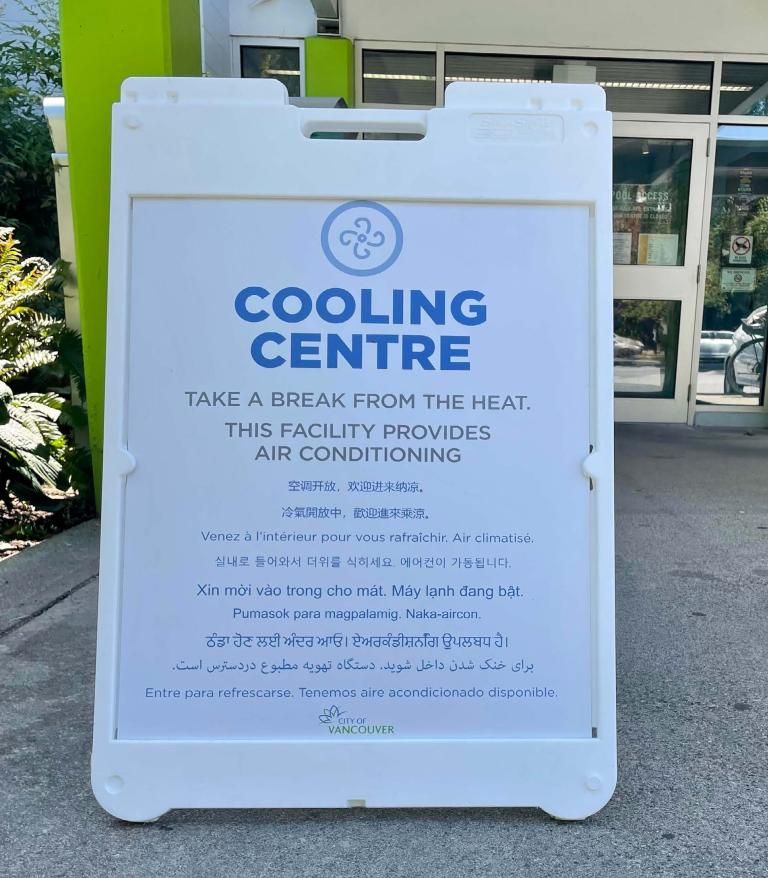
高溫警告和極端高溫緊急情況
為了應對 2021 年的熱蓋侵襲,多個衛生部門合作夥伴和加拿大環境及氣候變化部 (Environment and Climate Change Canada, ECCC) 為 2022 年夏季制定了卑詩高溫警報和應變系統(BC Heat Alert and Response System, BC HARS)。這個由兩個警戒級別構成的系統,列出了加拿大環境及氣候變化部 (ECCC) 發佈高溫警告(第 1 級)或極端高溫緊急警報(第 2 級)的標準,並配合這兩項警報的公共衛生資訊,以及為衛生部門和其他合作夥伴的行動建議。卑詩省將在未來幾年繼續完善和改進卑詩高溫警報和應變系統(BC HARS)。
在卑詩省疾病控制中心 (BC Centre for Disease Control, BCCDC) 的網站參閱更多有關卑詩高溫警報和應變系統(BC HARS)的資訊。
警報
高溫警告(第 1 級)
威脅:日間和夜間溫度高於季節常規標準,且溫度保持穩定。
行動:採取平常的措施來保持涼爽。
極端高溫緊急狀態 (第 2 級)
威脅:日間和夜間的溫度高於季節常規標準,而且溫度逐日攀升。
行動:啟動您的應急計劃。
溫哥華室內溫度調查
在 2021 年夏季,溫哥華市和溫哥華沿岸衛生局在卑詩省疾病控制中心的支援下,對室內溫度進行了自行報告的調查。這些資訊有助於我們更了解整個地區對室內和室外溫度之間的關係以及建築物特徵之間的關係。這項工作的目標是幫助提供有關在現有建築物內達到涼爽溫度的建議,並幫助預防高溫相關的疾病。
2021 BC Heat Dome and VCH ER Visits
Following the 2021 BC heat dome, the VCH Public Health Surveillance Unit studied data on emergency room visits in collaboration with VCH and Providence Health Care Emergency Medicine programs. Several key findings were identified:
The extreme heat event that affected much of British Columbia in 2021 resulted in a substantial increase in Emergency Department visits related to heat-related illness in VCH hospitals.
Rates of heat-related Emergency Department visits varied substantially by area of residence. Among the urban neighbourhoods in the VCH region, a higher rate of heat-related ED visits was observed among residents in the Downtown Eastside, Kensington, Victoria-Fraserview, North Vancouver City-East/West, and North Vancouver District Municipality –Central.
Among age groups, the highest rate of heat-related ED visits was among those aged greater than 80 years. Slightly more than half of heat-related ED visits and over 90% of hospitalizations among these visits were among those aged 65 years or older.
Comprehensive heat event preparedness is essential to minimize future health impacts, as the risk of extreme heat events in the context of a warming climate continues to evolve.
2021 BC Heat Dome and VCH ER Visits
Following the 2021 BC heat dome, the VCH Public Health Surveillance Unit studied data on emergency room visits in collaboration with VCH and Providence Health Care Emergency Medicine programs. Several key findings were identified:
The extreme heat event that affected much of British Columbia in 2021 resulted in a substantial increase in Emergency Department visits related to heat-related illness in VCH hospitals.
Rates of heat-related Emergency Department visits varied substantially by area of residence. Among the urban neighbourhoods in the VCH region, a higher rate of heat-related ED visits was observed among residents in the Downtown Eastside, Kensington, Victoria-Fraserview, North Vancouver City-East/West, and North Vancouver District Municipality –Central.
Among age groups, the highest rate of heat-related ED visits was among those aged greater than 80 years. Slightly more than half of heat-related ED visits and over 90% of hospitalizations among these visits were among those aged 65 years or older.
Comprehensive heat event preparedness is essential to minimize future health impacts, as the risk of extreme heat events in the context of a warming climate continues to evolve.
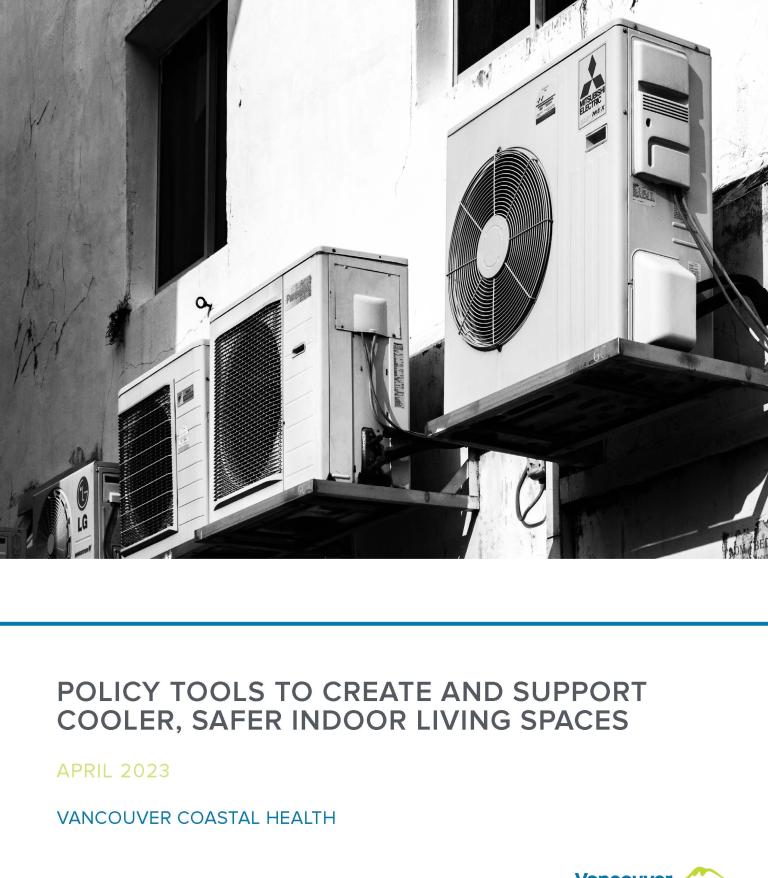
為建立和支持更涼快、更安全的室內居住空間的政策工具
溫哥華沿岸衛生局 (VCH) 為提升轄區內的家居熱溫度安全而審查了相關的政策和監管方案的措施。過程包括審視政策工具,以及與各級政府、房屋和租戶倡議組織,和房屋供應機構的關鍵知情人士進行了訪談。除了描述多項的政策選擇,報告指出有各級政府在多項政策上介入的需要,並克服成本和可行性等重大挑戰的應對方法,以及避免構成意料之外的後果。
下載報告:建立和支持更涼快、更安全的室內居住空間的政策工具極端高溫天氣資源
-
-
Public weather alerts for British Columbia
-
WeatherCAN weather app
Government of Canada
-
Hello Weather
Automated telephone service by the Government of Canada
-
-
-
Extreme heat poster
-
Extreme heat poster
-
Extreme heat preparedness guide
PreparedBC
-
Health checks during extreme heat events guide
NCCEH
-
Fans in extreme heat FAQ
Vancouver Coastal Health and Fraser Health
-
Build your own cool kit
Vancouver Coastal Health and the City of Vancouver (Find at the bottom of the page); Available in: English, Punjabi, Simplified Chinese, Traditional Chinese, Tagalog, Vietnamese.
-
Heat-related illness in infants and young children
HealthLink BC; Available in: English, Arabic, Chinese-Simplified, Chinese-Traditional, Farsi, French, Hindi, Japanese, Korean, Punjabi, Russian, Spanish, Tagalog, Ukrainian, Vietnamese
-
Prepared together for extreme heat
Building Resilient Neighbourhoods and Hey Neighbour Collective; Neighbour-to-neighbour connections may save lives during heat events. See tips to connect, learn, & collaborate with neighbours.
-
AC Care
Aboriginal Housing Management Association; Recommendations on safe and efficient operation of portable air conditioning units.
-
-
-
Extreme heat poster
VCH & Fraser Health (English, Arabic, Chinese-Simplified, Chinese-Traditional, Hindi, Korean, Farsi, Punjabi, Spanish, Urdu, Vietnamese and Gujarati)
-
Extreme heat poster
VCH & Fraser Health (English, Arabic, Chinese-Simplified, Chinese-Traditional, Hindi, Korean, Farsi, Punjabi, Spanish, Urdu, Vietnamese and Gujarati)
-
Extreme heat poster
VCH & Fraser Health (English, Arabic, Chinese-Simplified, Chinese-Traditional, Hindi, Korean, Farsi, Punjabi, Spanish, Urdu, Vietnamese and Gujarati)
-
Health checks during extreme heat events guide
NCCEH (English, French, Punjabi, Simplified Chinese, Traditional Chinese)
-
Heat check-In training slides
Vancouver Coastal Health
-
Heat check-in training: Train the trainer slides
Vancouver Coastal Health
-
Heat check-in practice scenarios
Vancouver Coastal Health
-
Heat check-in practice scenarios: Facilitation guide
Vancouver Coastal Health
-
Extreme heat preparedness guide
PreparedBC (English, French, Punjabi, Simplified Chinese, Traditional Chinese)
-
Heat related illness
HealthLink BC (available in multiple languages)
-
Beat the heat
HealthLink BC (English, Arabic, Chinese-Simplified, Chinese-Traditional, Farsi, French, Hindi, Japanese, Korean, Punjabi, Russian, Spanish, Tagalog, Ukranian and Vietnamese)
-
Heat stress information for workers
WorkSafe BC
-
Sample Heat and Wildfire Smoke Plan for Local Governments
Vancouver Coastal Health
-
Heat response planning for Southern Interior B.C. communities: A toolkit
Interior Health; Learn what your community can do to prepare for heat.
-
Outdoor Gatherings Guidance
Vancouver Coastal Health
-
-
-
Heat-check in support framework for non-governmental organizations
VCH
-
Emergency support for seniors framework
Renfrew-Collingwood Seniors' Society
-
Child care facilities and heat
VCH
-
Long-term care facilities and heat
VCH
-
Resource guide: Heat Planning
VCH and Health Emergency Management BC; How community care facilities can begin heat planning and recommended months for each step.
-
Heat Response Plan Template
VCH and Health Emergency Management BC; Fillable heat response plan template for community care facilities.
-
Site assessment checklist
VCH and Health Emergency Management BC; Detailed site and clinical checklists to assist community care facilities with heat planning.
-
Resident risk identification guidance
VCH and Health Emergency Management BC; Criteria to identify residents in community care facilities at highest risk from heat-related illness.
-
Heat response preparation checklists
VCH and Health Emergency Management BC; Brief checklist for community care facilities to complete before each heat season.
-
Heat response temperature log
Vancouver Coastal Health and Health Emergency Management BC; Indoor temperature recording template for community care facilities.
-
Heat response checklist
Vancouver Coastal Health and Health Emergency Management BC; Daily readiness check for community care facilities during heat alerts.
-
Heat-related illness: Prevention and Management in Community Care Facilities
Vancouver Coastal Health and Providence Health Care
-
Extreme Heat Guidance for Restaurants
Vancouver Coastal Health
-
Pool Operators on Extreme Heat and Smoke
Fraser Health
-
-
-
Recommended actions for owners and managers of rental and/or strata housing
By VCH & Fraser Health
-
For landlords and stratas: Heat planning resources for housing providers
BC Housing
-
Heat Stress
WorkSafe BC
-
How to be a heat-healthy business leader
Fraser Health
-
Resources for health professionals
-
-
Community care during extreme heat
Health Canada
-
Acute care during extreme heat
Health Canada
-
Health facilities preparation for extreme heat
Health Canada
-
Health facilities preparation for extreme heat
Health Canada
-
Technical guide for health care workers
Health Canada
-
For pharmacists (including medication risk factors)
Health Canada
-

